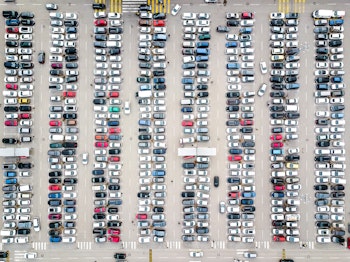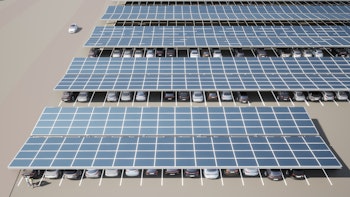
By Guy Chilvers
Even the most ardent car lover must admit that road vehicles have some drawbacks. They kill more than 1.3 million people a year in accidents worldwide. They are a major cause of noise and airborne particulate pollution.
And, of course, internal combustion engine-powered vehicles are a top source of the carbon emissions driving global warming. But there is one downside of motor vehicles that rarely gets mentioned: land use.
Unlike aircraft, which spend almost all their lives doing useful work in the sky, vehicles spend most of their time sitting around and waiting to be driven. In the US, for example, the average family car gets driven for only around an hour a day. That means cars are standing idle more than 95% of the time.
Given that there are more than a billion cars on the planet and each one needs an average of almost 17 square meters (180 square feet) to park in, vehicle ownership is immensely wasteful in terms of space. And it is a particular problem in cities.
According to the Columbia University Socioeconomic Data and Applications Center’s Gridded Population of the World database and the Global Rural-Urban Mapping Project, around 3.5 million square kilometres (1.4 million square miles) of land around the world is given over to urban space.
Based on estimates that say around 20% of urban land is devoted to off-street parking, that means car parks take up around 700,000 square kilometres (270,000 square miles) of the planet. To put this in context, there are only 39 countries in the world that are bigger than the sum of our car parks.
Conversely, the total amount of land that we use for car parking on the planet is larger than Afghanistan, France or Ukraine. This enormous expanse of tarmac only serves one purpose: to act as a resting place for cars. Shouldn’t we do something about this if we want a more sustainable world?
Thanks to the energy transition, we can. Today, when most cars are not parked then they are doing something even worse: producing fumes and carbon emissions that affect air quality and directly cause global warming, a potentially existential threat to humanity.
As we move towards a low-carbon energy system, electric vehicles could help avert the emissions problem. But they will give rise to a new challenge: where to source the electricity to power hundreds of millions of battery-powered machines worldwide.
Low-cost solar is an obvious choice for power, but it comes with its own land-use issues. The amount of land required for solar energy production varies greatly by location but averages around 16,000 square metres (19,000 square yards) per megawatt.
Finding such large amounts of land for solar power production is not hard in rural areas, but in cities it can be more difficult.
Rooftops are often the only readily available real estate, and if they are already used for community solar arrays then they may not offer much leftover power for electric vehicle charging. Another option is to ship solar power in from out of town, of course.
But this may require expensive upgrades to grid infrastructure that is already being stressed by the need to cater for intermittent renewable production. Against this backdrop, placing solar panels on car park canopies is a no brainer.

After all, this is space that is already being used to house cars, so the need for distribution infrastructure is minimal.
And the amount of power that could be harnessed by covering the world’s car parks with solar canopies is vast: around 43 terawatts (TW), based on the area-per-megawatt average cited above. How much is 43 TW, though?
In 2020, according to the International Renewable Energy Agency, the total installed capacity of renewable energy in the world—including the planet’s vast hydro reserves—amounted to just under 2.8 TW.
So, covering car parks with solar panels could potentially yield more than 15 times all the renewable energy capacity in the world.
That should be enough not just to power the world’s electric vehicles but also pretty much supply all the energy needed for society, even including a fair amount to create green hydrogen or other low-carbon fuels for hard-to-abate sectors such as aviation and steelmaking.
Not only that, but solar canopies could offer further benefits. For car owners, there is the prospect of always having a vehicle that is fully charged with cheap (or even free) solar energy, not to mention being protected from heat, dust, rain, bird droppings and so on.
For car park owners and operators, there is the opportunity to provide a value-added service to customers, demonstrating a clear commitment to global sustainability and at the same time potentially bringing in new revenues from energy sales to the grid.
And for urban dwellers in general, there is the potential for cheap, locally sourced clean energy, pollution-free traffic and—in hot countries—an urban landscape that offers greater shade from the midday sun.
Most importantly, the tarmac deserts that dominate cityscapes today could be put to good use in fighting global warming, one of the most vexing challenges facing our society today. That’s the vision, at least. Naturally, things might be more complex in practice.
Not all car parks might be suitable for solar canopy installations, for example. And solar canopy buildouts will likely need to be accompanied by a massive investment in energy storage if most of the power produced is to be made available when it is needed the most.
Despite this, the benefits of solar canopies are undeniable. And the technology and benefits are available here and now, not destined to become reality in some distant future.
For this reason alone, it is hard to argue against including solar canopies in any new car park development going ahead today—and retrofitting the structures to existing parking facilities wherever possible.
Publish date: 28 April, 2022